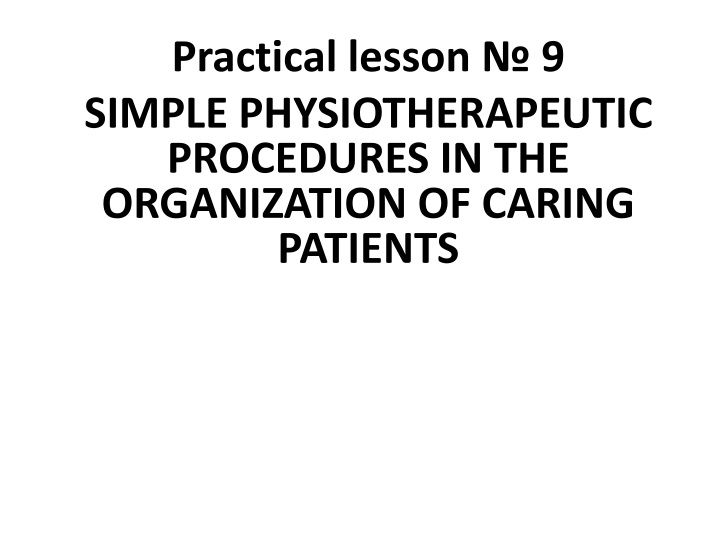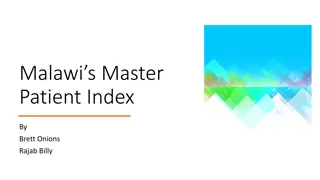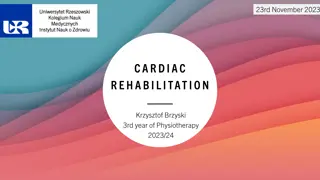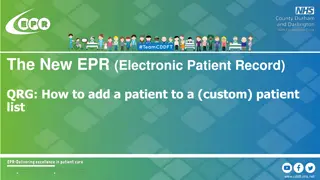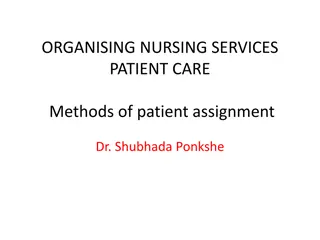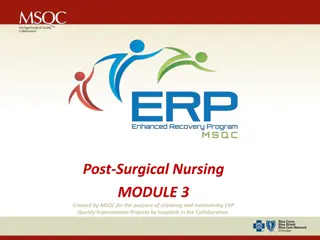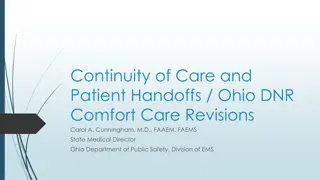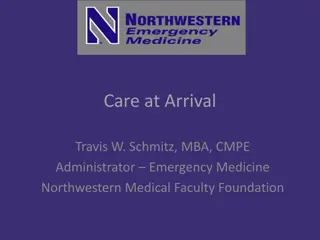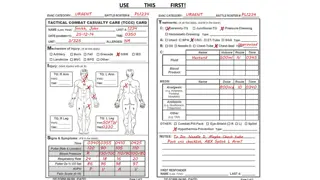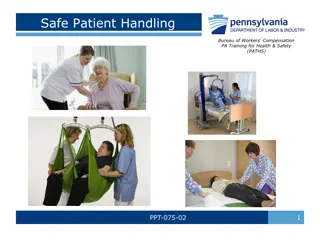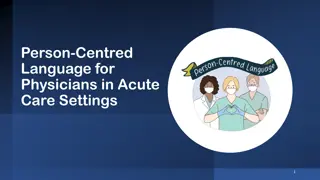Simple Physiotherapeutic Procedures in Patient Care
Physiotherapy, a branch of medicine, utilizes natural or artificial physical factors to promote health and recovery. This lesson focuses on the application of heat and cold, understanding their physiological effects, classifying hot applications, and listing indications for therapeutic uses of hot applications.
Download Presentation

Please find below an Image/Link to download the presentation.
The content on the website is provided AS IS for your information and personal use only. It may not be sold, licensed, or shared on other websites without obtaining consent from the author.If you encounter any issues during the download, it is possible that the publisher has removed the file from their server.
You are allowed to download the files provided on this website for personal or commercial use, subject to the condition that they are used lawfully. All files are the property of their respective owners.
The content on the website is provided AS IS for your information and personal use only. It may not be sold, licensed, or shared on other websites without obtaining consent from the author.
E N D
Presentation Transcript
Practical lesson 9 SIMPLE PHYSIOTHERAPEUTIC PROCEDURES IN THE ORGANIZATION OF CARING PATIENTS
Physiotherapy is a branch of medicine that studies the effect on the human body natural or artificially received physical factors and using them for the purpose of saving, recovery and promotion of health Local Application of heat and cold to the body can be therapeutic, but before using these therapies, the nurse must understand normal body responses to application of heat and cold and how and when to use.
HOT APPLICATION Hot application is the application of a hot agent, warmer than skin either in a moist or dry from on the surface of the body.
PHYSIOLOGICAL EFFECTS HOT APPLICATION Peripheral Vasodilatation Increased capillary permeability Increased oxygen consumption Increased local metabolism Decreased blood viscosity Decreased muscle tone Increased blood flow Increased lymph flow COLD APPLICATION Peripheral Vasoconstriction Decreased capillary permeability Decreased oxygen consumption Decreased local metabolism Increased blood viscosity Increased muscle tone Decreased blood flow Decreased lymph flow
Classification of Hot Applications HOT APPLICATIONS LOCAL: GENERAL: Dry heat: Hot water bottles Chemical heating bottles Dry Compresses Infrared rays Ultraviolet rays Short wave diathermy Heating lamps Electric cradles Electric heating pads Moist heat Hot Compresses Warm soaks (Local baths) Poultices (cataplasm) Stupes (medical fomentations) Paraffin baths Sitz bath Aquathermia pad Dry heat: Local bath Sun bath Electric cradles Blanket bed Moist heat General bath Steam baths Hot packs Whirlpool bath (Full immersion bath)
List the indications for therapeutic uses of hot applications Spastic pain (in the stomach, gallbladder, intestines); Spasm muscle tone; Hypothermia (Provide warmth); Accelerates regeneration processes (by increasing blood flow); Inflammatory process before the formation of pus (Resolving action).
List the Contraindications for hot applications Malignancies Impaired kidney, heart & lung functions Acutely purulent Inflammatory process Open wounds On clients with paralysis Edema associated with venous or lymphatic diseases Headache Very young & very old client Client with very high temperature
List the Complications of the hot applications Burns Maceration (with moist heat) Redness of the skin Edema Hyperthermia
COLD APPLICATION Cold application is the application of a cold agent cooler than skin either in a moist or dry form, on the surface of the skin;
Classification of cold Applications COLD APPLICATIONS LOCAL: Dry cold: Moist cold: Ice pack Chemical cold packs Ice to suck Evaporating lotion GENERAL: Dry cold: Local bath Moist cold: General Cold bath Cold sponging Cold wrapping Cold compress
PHYSIOLOGICAL EFFECTS HOT APPLICATION Peripheral Vasodilatation Increased capillary permeability Increased oxygen consumption Increased local metabolism Decreased blood viscosity Decreased muscle tone Increased blood flow Increased lymph flow COLD APPLICATION Peripheral Vasoconstriction Decreased capillary permeability Decreased oxygen consumption Decreased local metabolism Increased blood viscosity Increased muscle tone Decreased blood flow Decreased lymph flow
List the Indications for therapeutic uses of hot applications Acute injury (the first day) Relieves pain (anaesthetize an area) (in the injury area) Reduce edema (in the injury area) Reduce inflammation (in the injury area) Control hemorrhage Reduces the body temperature Control the growth of bacteria ( acute abdomen )
List the Contraindications for cold applications Cold allergy/hypersensitivity Uncovered open wounds Compromised circulation Cardiac disorder Anesthetic skin Advanced diabetes
COMPLICATIONS OF COLD APPLICATIONS Pain Blisters and skin breakdown Maceration (with moist cold) Grey or bluish discoloration Thrombus formation Hypothermia
FACTORS AFFECTING HEAT AND COLD TOLERANCE Body part: Certain areas of the skin have a sensitivity to temperature variations. The inner aspect of the wrist and forearm, the neck, and the perineal area are temperature-sensitive, while the back of the hand and the foot are not as sensitive. Duration of application: Therapeutic benefits of heat and cold applications are achieved with short periods of exposure to temperature variations. Tolerance increases as the length of exposure increases. Area of body exposed: The larger the area exposed to heat and cold, the lower the tolerance to temperature changes. Damage to body surface area: Injured skin areas are more sensitive than intact areas to temperature variations. Individual tolerance: Tolerance to temperature variations is affected by age and physical condition. The young and the aged are especially susceptible to heat and cold. Neurosensory impairments may interfere with the reception and perception of stimuli, increasing the risk of injury. Age: Thinner skin layers in children and elderly people increase the risk for burns from the heat and cold applications. Scientific principles involved in hot and cold applications: Water is a good conductor of heat. Air is a poor conductor of heat. The flow of heat is from the hotter are to the less hot area. Prolonged exposure to moisture increases the skin s susceptibility to maceration and skin breakdown, reducing the protection of the intact skin. Moisture left on the skin causes rapid cooling due to evaporation of the moisture Presence of steam increases the temperature of the hot application. Oil acts as insulator and delays the transmission of heat. Woolen absorb moisture slowly, but hold moisture longer and cool off less quickly than the cotton materials.
PRACTICAL SKILLS: Hot water bottle Hot water bottle Ice pack
Hot water bottles (Dry heat) Ahot water bottle is a container for local effects of dry heat on any part of the body. Types of medical hot water bottle: Rubber (water); Electrical; Chemical.
Hot water bottle Equipment: hot water bottle, water 60-70 , thermometer for measuring water temperature, napkins. The algorithm of actions: 1. Explain to the patient the purpose and procedure course. Obtain patient's consent. 2. Give to patient the comfortable position. 3. Wash hands. Wear gloves. Prepare equipment. 4. Fill the hot-water bottle with hot water on 3/4. 5. Remove the air with compression of the top third of a hot-water bottle, close stopper. 6. Turn over the hot-water bottle, check the tightness. Drain a hot water bottle. 7. Wrap the hot-water bottle in napkin, put it on the necessary area of a body, then cover the patient. Keep 20 minutes. 8. In 5 minutes check there is an overheating of tissue (If there is sensitive skin problems). 9. In 20 minutes remove the hot-water bottle, to examine the skin integuments. Cover the patient and provide rest. 10.Take off the gloves and put them in the container for waste class . 11.Wash hands hygienic way. 12.Make a record of results in a medical documentation.
Moist hot compress Equipment: 6-8 layered gauze napkin, waxed paper, bandages, scissors, solution for cloth wetting (indoor temperature water, 40% pure alcohol or 6% vinegar solution). Algorithm of actions: 1. Explain the purpose and procedure course. Obtain patient s consent. 2. Wash hands. Wear gloves. Prepare equipment. 3. Examine the skin of the patient at the place of compress appliance. 4. Moisten the gauze napkin with one of the solutions and well squeeze, put 6-8 layered gauze napkin on the skin. 5. Cover the napkin with a piece of waxed paper (oilcloth) that is 1.5-2 cm more than the previous layer. 6. Cover with a cotton wool layer that is 1.5-2 cm more than the previous layer. 7. Fix the compress with a bandage so that it is densely adjusted to the skin but doesn t hamper. 8. Record the time of compress application. 9. Wash the hands sanitarily. 10. In 1-2 hours by pushing a finger under the compress make sure that the napkin is damp, and the skin is warm (if the napkin is dry the compress is applied incorrectly). 11. Keep the compress for 6 - 8 hours then remove it, wipe the skin with warm water, dry with the napkin. 12. Wash the hands the sanitarily. 13. Make a record of what you have done. Remember! The compress is imposed correctly if the gauze adjacent to skin, after removal of a compress remains warm and damp.
Ice pack Equipment: ice pieces, ice pack, sheet of fabric, cold water, wtch, thermometer to measure the water temperature. Algorithm of actions: 1. Explain the purpose and procedure course. Obtain patient s consent. 2. Wash hands. Wear gloves. Prepare equipment. 3. Fill half of the pack with small pieces of ice, pour them with cold water. 4. Put the ice pack on a horizontal surface, close with lid. 5. Wrap the ice pack in 4 layered sheet of fabric and place it on the necessary site of the body: head area 5 minutes (with 5 minute interval); peritoneum area 15-30 minutes (with 30-60 minute interval). 6. Remove the ice pack. Cover the patient and provide a rest. 7. Wash the hands sanitarily. 8. Make a record of what you have done. Remember! if there is a sharp pain because of the ice pack pressure it is hung over the sore area; in case of the repeated use of the ice packs, it is obligatory to use newly prepared ice pack; when using pack with frozen (in a freezer) water frostbite of a body part can occur.
